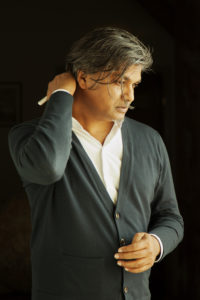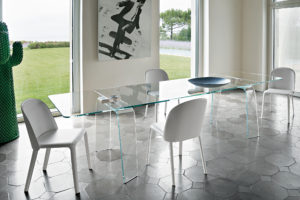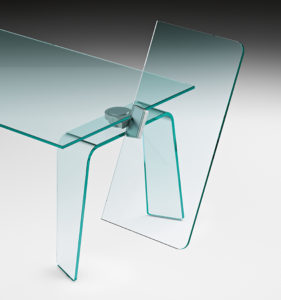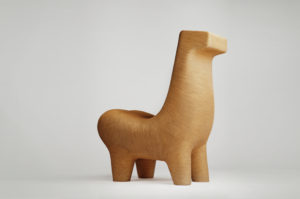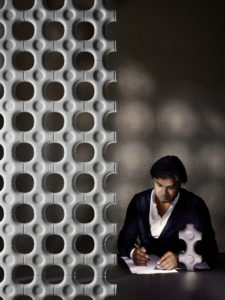Satyendra Pakhalé is a toast of the design world. His studio in Amsterdam is involved in cutting-edge, high end design projects across the world, with his design business sprawling from Italy to the US.
Satyendra Pakhale
Satyendra Pakhalé, an India-born, Amsterdam-headquartered designer, is well known for his innovative streak and his experimental design. The newest design from the Satyendra Pakhalé studio that is being talked about is the Kayo extensible table, which he has created for Italian glass furniture company, FIAM.
FIAM, Kayo Extensible Table
Crafted entirely of glass, the seamlessly transparent table is marked by its reflective surface and technological precision. Bent glass legs and extensible parts feature in the design, which means the table can be extended by either two or three metres. Talking about the creative process, Pakhalé says, “Making things has not changed much over the years. Artefacts have been made using similar processes and materials for hundreds of years. But once in a while there is a break-through. When I was invited a few years ago to visit the FIAM pioneering manufacturing plant on the beautiful Italian east coast near Pesaro it felt like being in an aerospace industry. Passionate people in thermal protective aprons with cultivated skills and techniques, which did not exist earlier, were engineering objects out of industrial glass with high temperature regulated furnaces. This way of making artefacts, through a process needing the synthesis of technological know-how, is what FIAM has pioneered for 40 years.” This table of considerable length has only two supporting pivots. Its main plane with bent glass legs and extensible parts are connected by a compact mechanism that simply operates with one knob, extending the table from two to an impressive three meter span.
FIAM — Kayo Extensible Table
Innovations like these aren’t a one-off thing for the alumni of IIT and Art Center College of Design, Switzerland. Pakhalé’s practice has developed a worldwide reputation for designing diverse innovative typologies, pushing the limits of technology and materials. His limited edition, cutting-edge design pieces are represented as works of art by the ammann//gallery, Cologne, Germany and his works are in permanent collections at prestigious museums across the world. The designer, who was in India a couple of months ago for the Government of India’s ‘Made in India’ initiative, has also worked with Indian artisans to update their centuries-old skills.
BM – Horse
His studio works with brands and manufacturing companies like Poltrana Frau, FIAM and Cappellini – the ultimate design luxury brands who understand luxury as quality of living condition coupled with high craftsmanship and heritage. “They realise that design is strategic to their business and long sellers along with best seller products matter. Just to mention, in every design meeting, the CEO of the company is always present. Not just a project manager conducts design meetings, because it forms the strategic core of their business activities,” he says.
In India, however, design is still viewed as an aesthetic tool then as a tool of function. “Design as a discipline is often misunderstood. Design is a profound, structural thinking approach, a strategic tool, which can be used for all kinds of applications, particularly in industry, manufacturing and above all to bring positive change to global living conditions—that is how we practice design as a discipline,” he insists.
Pakhalé says he discovered design through the profound writings of (American industrial designer) George Nelson. “Sitting in the middle of India, in Nagpur, I stumbled upon a tiny book written by him. I ran to my professor and told him this is what I wanted to do. Besides working with great design companies, Nelson wrote prolifically on matters of design in a manner that even kids could understand.”
He studied design at IIT Bombay Industrial Design Centre (IDC), before moving to the US and then to Paris. “My first great international exposure was in Paris and I have several friends in the city. So I was contemplating if Paris should be my base. But Amsterdam is a world metropolis, but on a very human scale in terms of size. And it has a beautiful light. There is a special documentary made on the light in Amsterdam. No wonder the city has given birth to so many great artists. As soon as I arrived (in Amsterdam), the support from the design and architecture community was positive. My work is extremely spread out across planet and even outside the planet, as you see in the Moonwaka project, but my base for now is Amsterdam. The good thing about some countries – and Holland ranks as one of those countries, besides Denmark and a few others – is that the creative economy is on the national agenda. The Netherlands consuls and ambassadors are closely involved in all the international design events and activities as design profession is recognised as one of the key for economic growth. Majority of the institutions in these countries – educational, cultural and design – support the creative economy,” adds Pakhalé.
Add on Radiator
Among his many industrial design projects is an Add-On Radiator. “It is refreshing way to look at the radiator that could be seamlessly integrated in architecture,” he informs. “After more than a decade now it still remains the most innovative radiators in the market.” Pakhalé has also worked with Bastar artisans in India. “We are deeply engaged with materials and technologies and if one looks at our early work, it has predominantly been in the technological sector. Often in a conventional industrial context technology for the sake of technology does not mean much, it loses its sensorial and symbolic content,” he says. “India, on the other hand, is an ancient culture with a long heritage of making things and amazing amount of skill, but both firmly stuck in the past. The curiosity was to understand and apply those skills to create products that are fresh, modern, contemporary, but with a deeply sensorial quality. Indians are uniquely sensorial in the way we talk, eat and live. That is the quality I am after. I chose Bastar craft to create contemporary objects, sculptural forms that evoke sensorial feel what we call ‘forms of feelings’ with poetic analogies and with new ways of thinking. And by doing so pushed the current limitations of making an object and synthesized a new process of making a seamless metal object.”
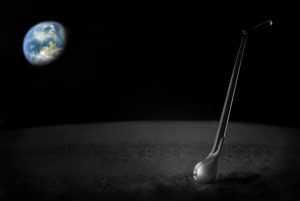
Moonwaka Product Shots
Among his other upcoming projects is a Humanitarian Helicopter project, which he presented it California in March this year. The helicopter doesn’t need a runway to land or take off. It has special landing gear that allows it be all-terrain. Then there is Moonwaka, a magical project that pushes the limits and perception related to space exploration and its implications as regards societal invention. “If you look at conditions on planet Earth, one realises most problems are man-made. Needing our utmost attention are pressing issues such as human sanitation, malnutrition and access to education. The challenge is just how to get it done in current conflicts, where the failure of the system is the real issue. We need radically new thoughts, new ideas, new ventures and a refreshingly new approach to the challenges we face,” he says.
For Pakhalé, the journey from designing a chair to designing a moonwalker is a journey of constant experimentation and lateral thinking. “For me objects are like companions and I am fascinated by the possibility of bringing life, elegance and even dignity into them. I always want to create a stately physical presence into my work without compromising the utility, so people do not throw them away, but build a special life long bond with them.”

